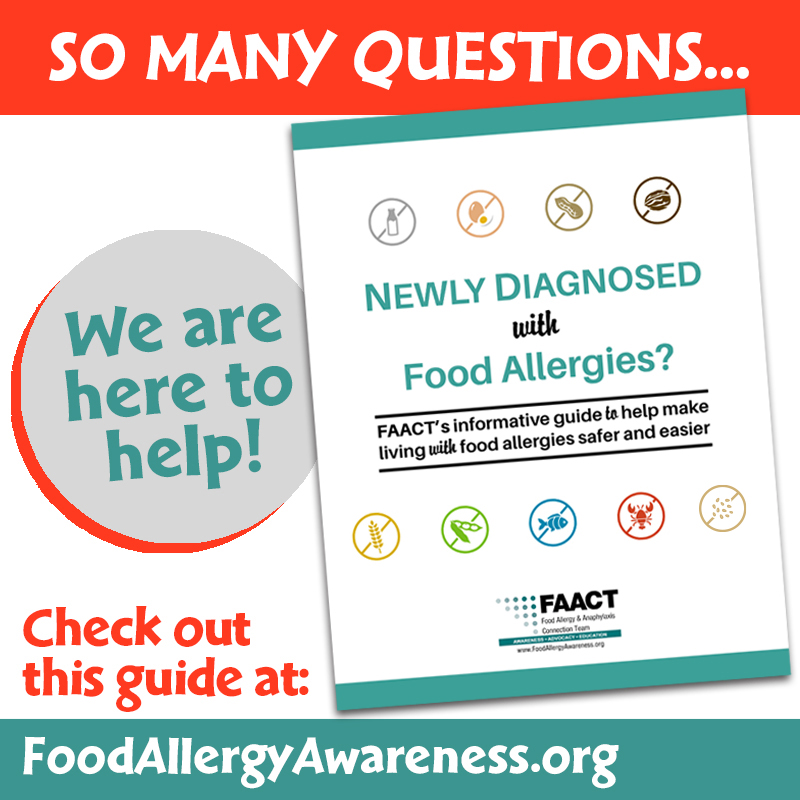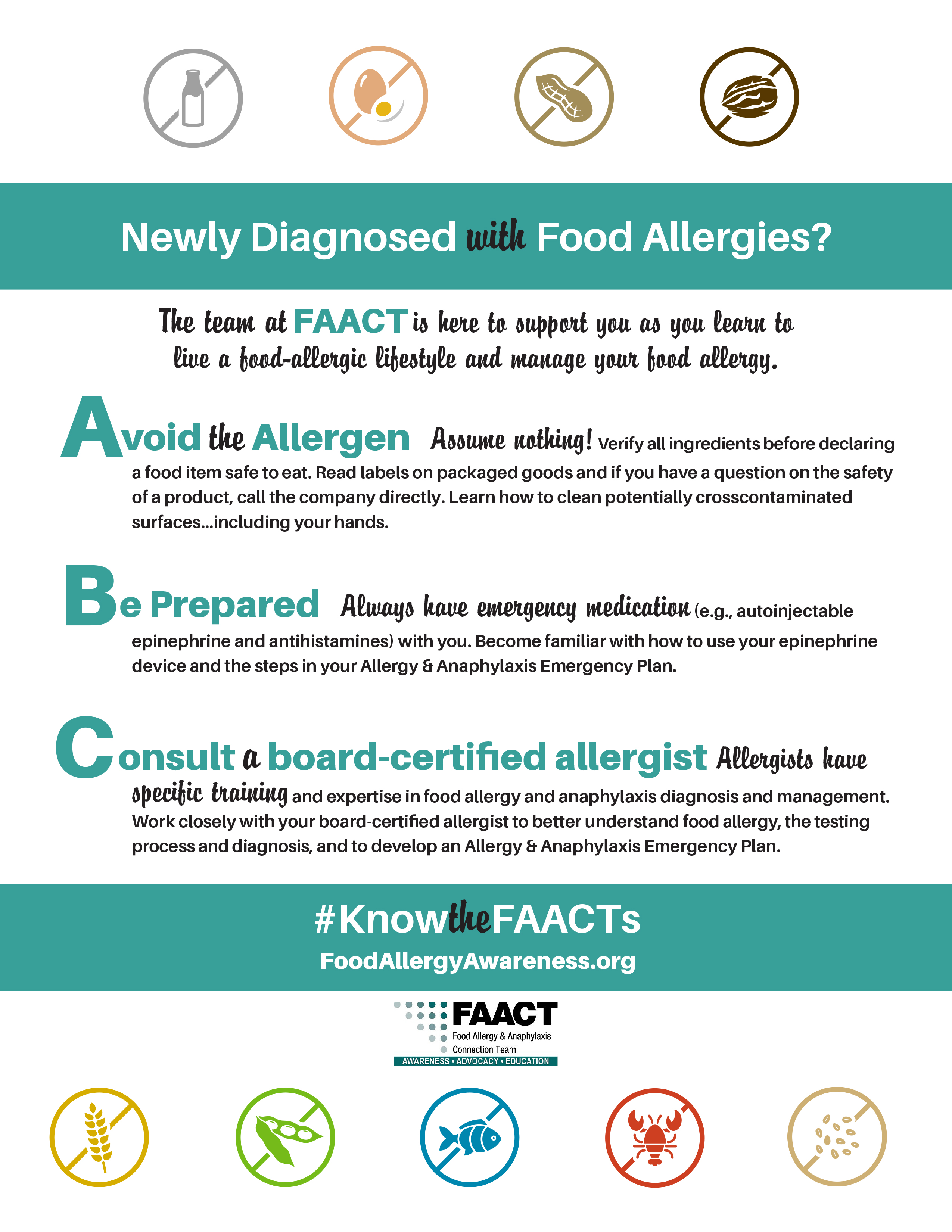Newly Diagnosed

Tips for the Newly Diagnosed
Were you or your child just diagnosed with a food allergy? Did you know as many as 32 million Americans live with food allergies?
The team at FAACT is here to support you as you learn to live a food-allergic lifestyle and manage your food allergy. You are not alone. Very few people are not directly or indirectly affected by food allergies. Having a food allergy does not have to be an overwhelming experience. We want you to view food allergy as a manageable obstacle that you can overcome.
We also want to provide you with some basic survival tips to help make living with food allergy as easy as possible. See below for tips, and download our free, Newly Diagnosed Guide here for more tips and resources.
TIPS
1. Consult a board-certified allergist. Finding an allergist is easy. The American Academy of Allergy, Asthma, and Immunology and the American College of Allergy, Asthma, and Immunology Web sites can help you find a local allergist. Allergists have specific training and expertise in food allergy and anaphylaxis diagnosis and management beyond pediatricians or family doctors.
Work closely with your allergy provider to better understand food allergy, the diagnosis and testing process, and the long-term follow up. Experts recommended that you follow with your allergy provider annually to update your Allergy & Anaphylaxis Emergency Plan and renew prescriptions for auto-injectable epinephrine and other medications. If your child is the one with food allergies, your allergist should also fill out school paperwork for emergency medication administration (if your state requires this) as well as facilitate dialogue with schools or childcare centers for section 504 plans or other individualized learning plans.
2. There is no way to prevent an allergic reaction other than avoiding the allergen. Strict avoidance is the best way to prevent a reaction. This includes all products that definitely contain the allergen as well as those that “may contain,” "manufactured in a shared facility", or “processed on the same equipment.” Experimenting or taking risks to determine if you can tolerate small exposures to the food allergen is dangerous and will likely result in an allergic reaction. Oral immunotherapy is an experimental research procedure with uncertain results. No one should attempt this therapy or other desensitization therapies by themselves at home - without the guidance of their board-certified allergist. Likewise, oral challenges to prove tolerance should not be performed at home; this should only be done under medical supervision in an allergist’s office.
3. Always have emergency medication (e.g., epinephrine auto-injectors and antihistamines) with you. While we preach avoidance and vigilance, we also stress preparation. People with food allergies must always be prepared for the worst-case scenario. Every time you leave the house, you must take your emergency medical kit. All too often, food-allergic individuals simply do not comply with this recommendation – and they take a huge risk. Epinephrine is a life-saving medication that can rapidly reverse all symptoms of an allergic reaction if administered as soon as anaphylaxis is suspected. Food allergy fatality is associated with lack of available epinephrine or a delay in administration. (Note: Epinephrine devices should not be left in the car because extreme temperatures – hot or cold – can affect the effectiveness of the medication.)
4. Become familiar with how to use your epinephrine auto-injector device and the steps in your emergency care action plan. It is essential to not only have your epinephrine auto-injector device with you at all times, but also to know how to use it. Make sure you have been trained by a medical professional to use the device. Even young children can and should learn to use these devices on themselves. If you or your child have not been trained, there are several Web sites with video demonstrations. It is essential to train others who will be in close contact with your or your child how to use the device as well. Similarly, people with food allergies, their caretakers, and close contacts must be intimately familiar with the treatment steps outlined in the emergency care action plan. There can be no hesitation in the moment of need. Baby sitters, nannies, school teachers and administrators, coaches, and other family members must all know how and when to administer epinephrine. There are no situations in which it would be wrong to use an epinephrine device to treat an allergic reaction.
5. Assume nothing is safe. Verify all ingredients before declaring a food item safe to eat. Recipes at restaurants and in packaged goods change, so double check the ingredients every time. When dining out or purchasing food items from shops such as a bakery, ask lots of questions. Ask if common preparation surfaces, cooking utensils, or pots/pans/baking sheets are used, ask how these items are cleaned and if an allergen-free environment can be provided. It is essential to ask restaurant staff these questions as well. Use written allergen instruction cards whenever possible, and try to speak with the restaurant manager and/or chef in advance to determine if it will be possible for you or your child to safely eat at that establishment. If you ever are served a dish you suspect to be contaminated with your food allergen, hold onto that dish until a new one can be prepared and served (to ensure the staff don’t simply “wipe off” the allergen). Above all else, if you cannot confirm that the food item is safe to eat, don’t eat it!
6. Read labels on packaged goods. Since 2006, federal law mandates all packaged goods containing milk, egg, wheat, soy, fish, crustacean shellfish (but not mollusks), peanut, or tree nut be labeled in plain English declaring the presence of these allergens. However, when the allergens are not main ingredients but could be included in the packaged goods through cross-contact, a product may be voluntarily labeled as “may contain,” "manufactured in a shared facility", or “processed on the same equipment.” The certainty of what these precautionary statements mean is not always clear. It may mean there is likely contamination, or it could be a legal declaration that the company cannot guarantee the total absence of an ingredient (even if they make nothing that contains that ingredient). Read all labels on packaged goods first. The labeling may not be perfect, but it is helpful. Most allergists recommend strict avoidance of products with precautionary statements if that product had not been safely consumed in the past, although this advice may shift as more research into threshold levels emerges.
7. Learn how to clean potentially cross-contaminated surfaces – including your hands! Soap and water and commercial detergent wipes are your friends, but gel hand sanitizer is not. Do not use gel hand sanitizer to clean your hands after allergen contact. That is not effective. Use soap and water. If those are not available, use a hand wipe. For cleaning contaminated surfaces, do not use dish soap. (Studies show that dish soap is not effective in removing peanut allergens.) Instead, use a commercial detergent wipe (e.g., Clorox®, Lysol®, etc.) or a commercial spray detergent (e.g., Fantastic®, Formula 409®, Lysol®, Windex® Multi-surface, etc) and clean towel. For dishes, vigorous scrubbing with dish soap and water followed by cleaning in the dish washer is recommended. Allergic reactions can be triggered through ingestion of trace amounts or residual amounts of food protein on someone’s hands, which can also contaminate common surfaces. This is particularly important among small children who may frequently put their hands – and everything else – in their mouths.
8. Discourage food sharing. Unless you can verify that all the ingredients are safe, do not accept food from others. If your child has food allergies, ensure he or she follows this practice at school, on field trips, at sporting events, and at friends’ homes. Never assume the food being offered is safe or was safely prepared unless you can personally verify this.
9. Order a medical ID bracelet, necklace, or tag. No one wants to think about that dreadful day when an emergency comes around. The fact is you must be prepared in every way to ensure you and/or your child are treated properly for anaphylaxis.
- 95% of first responders immediately look for a medical ID in an emergency. They need to be able to treat your child effectively. Knowing if there are allergens to foods, medications or otherwise is pertinent to them doing so.
- You may not always be able to speak for your child if they are not in your care. The medical ID gives those helping your child the information needed regarding their medical conditions.
- Your child may be in a situation where they cannot speak for themselves!
- A Medical ID gives those in your child’s life daily the information they will need, such as school nurses, teachers and caregivers.
· If your considering using an iPhone or technical device, you may want to think again. A medical ID bracelet, necklace or tag is assurance that when your child needs help they will receive. It is reliable. Emergency responders are trained to look for medical ID’s. Technology devices may not be as reliable, if they are not present at the time, and it can be very time consuming trying to figure out how to get into a technical device. During an emergency like anaphylaxis there is not a minute to waste.
10. Become empowered! Living with a food allergy is entirely manageable. Yes, this requires attention to detail and vigilance, and it means that certain foods have to come out of the diet. But it does not mean that life as you know it will cease to exist. With some simple safety parameters, you can still eat out, send your child to school or on play dates, travel, and live a normal life. We want you to take proper precautions – not become a prisoner of your own home. Maintaining a normal life and routine is of the utmost importance for building your self-confidence or your child’s confidence. Learn as much as you can about food allergy, what the risks are, and how to protect yourself and your family. Become a strong advocate. Try to teach those around you about the dangers of food allergy and how to treat a potential reaction. Use the FAACT Web site as your guide on how to navigate a food-allergic lifestyle.
You are leaving ODACTRA.com
and being directed to a third-party website. Please note that this third-party website is not controlled by ODACTRA.com or ALK, Inc., or subject to our privacy policy. If you do not wish to leave, click Cancel; otherwise click OK to continue. Thank you!

Resources
FAACT's Newly Diagnosed with Food Allergies Poster
Food Allergy Safety: It's A Matter of FAACT
Accurately Diagnosing a Food Allergy
Effectively Managing a Food Allergy
Epinephrine Auto-Injector Options Poster
Allergy & Anaphylaxis Emergency Plan (AAP)
Visit FAACT's Education Resource Center for FREE and downloadable resources.
